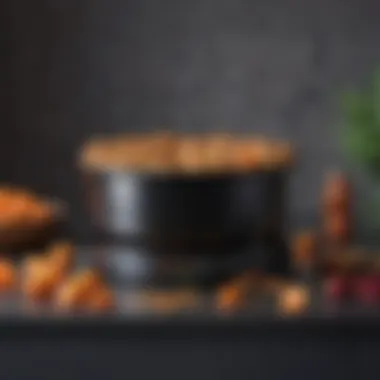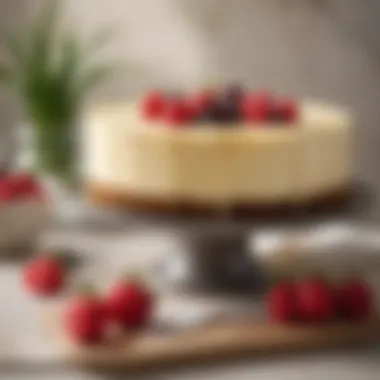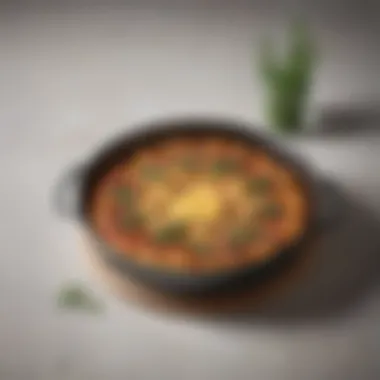Mastering the 8 Inch Springform Pan: A Culinary Guide


Intro
The 8-inch springform pan serves as a fundamental piece of equipment for both amateur and professional chefs. Its unique design, featuring a removable base and side, allows for the effortless removal of delicate dishes. Understanding this pan's capabilities is essential for enhancing one's culinary repertoire. By exploring its diverse applications, maintenance methods, and specific ingredient considerations, individuals can maximize their baking and cooking experiences.
Why Focus on the 8-Inch Springform Pan?
The 8-inch size holds a strategic advantage; it is not too large or too small, making it suitable for various recipes. Whether one desires to prepare a luscious cheesecake, a rich torta, or even a savory dish like a layered lasagna, the 8-inch springform pan proves to be exceptionally versatile. Such adaptability is invaluable in modern kitchens, where space and utensil availability may be limited.
Engaging with this article will deepen your understanding of the springform pan's functionality and inspire you to use it creatively.
"The beauty of the springform pan is in its ability to cater to both sweet and savory dishes, making it an essential kitchen tool."
As we move forward, we will detail the aspects related to its design, functionality, and maintenance tips, ensuring you grasp the full potential of the 8-inch springform pan.
Preamble to the Inch Springform Pan
The 8-inch springform pan stands as a fundamental tool for both professional bakers and enthusiastic home cooks. Its design allows for the effortless release of delicate cakes and tortes, making it essential for those who wish to achieve a flawless presentation without compromising the integrity of their creations. The concept of the springform pan itself is not new; however, its versatility in various culinary applications has increased its popularity in recent years.
One of the primary benefits of the 8-inch size is its adaptability. It is neither too small nor too large, fitting comfortably in most ovens and suitable for a variety of recipes. From creamy cheesecakes to layered cakes, the springform pan allows the user to experiment with different textures and flavors. In addition, the pan's unique mechanism, which consists of a removable bottom and a clamping ring, provides a convenience that traditional pans lack. This feature helps to maintain the shape of the dessert while making serving significantly easier.
Considerations are also paramount when selecting a springform pan. The material and build quality directly influence both performance and durability. Pots that come with non-stick coatings often simplify the baking process, but they must be handled with care to prevent scratching. Additionally, the ability to withstand varied introduction of heat is vital when working with delicate mixtures, such as cheesecakes, which require gradual baking.
In this article, we will dissect the multiple dimensions of the 8-inch springform pan. Our exploration will delve into its design features, common uses, and maintenance strategies to help culinary aficionados maximize their experience with this kitchen essential. By gaining a deeper understanding of its function, readers will be better equipped to craft culinary delights that leave a lasting impression.
Design Features of Springform Pans
The design features of springform pans are essential for understanding their functionality and versatility in the kitchen. Specifically, these features enhance the user experience and improve the quality of the dishes prepared. By focusing on the materials, mechanism, and unique attributes, one can appreciate how these pans serve various culinary needs effectively.
Materials Used
Non-stick Coating
Non-stick coating is a significant aspect of many springform pans. This feature greatly contributes to the ease of use and maintenance. The primary characteristic of non-stick coatings is their ability to prevent food from adhering to the surface. This is particularly beneficial for delicate items like cheesecakes.
The unique feature of non-stick coatings includes its ability to create a smoother release for baked goods. This reduces the risk of breakage during unmolding, which is crucial for presentation. However, one should be cautious, as non-stick coatings can wear off over time, necessitating careful cleaning and storage to maintain their effectiveness.
Aluminum vs. Steel
The choice between aluminum and steel materials drastically affects the functionality of a springform pan. Aluminum is lightweight and heats quickly, providing even heat distribution. This helps achieve uniform browning, an important aspect for certain recipes. On the other hand, steel pans offer greater durability and resistance to warping.
A unique characteristic of aluminum pans is their susceptibility to scratching and dents. While they might be preferred by some bakers for their heats conductivity, steel pans may be more suitable for long-term use. Ultimately, the choice between aluminum and steel depends on individual preferences and cooking styles.
Silicone Options
Silicone springform pans present modern alternatives to conventional materials. Their key characteristic lies in flexibility, allowing baked goods to be easily removed without sticking. This can be particularly useful for cheesecakes, as it minimizes the risk of cracks.
One of the major advantages of silicone options is their resistance to extreme temperatures. They can handle both freezing and baking without damage. However, these pans may not yield the same level of crispness as metal pans, which can be a point of consideration when deciding their suitability for specific recipes.
Mechanism of the Springform Closure
Unlocking and Removal
The unlocking mechanism of a springform pan is a crucial design feature. This allows for a simple and effective way to remove the sides without disturbing the integrity of the dish. The ease of unlocking is a key characteristic, making it popular for those who frequently bake delicate desserts.


The unique feature of the unlocking mechanism is its hinged design. This facilitates quick access to the baked item. It's important to ensure that the lock functions properly, as a failing mechanism can ruin a dish.
Ensuring a Tight Seal
A tight seal is vital for achieving the intended baking results. This feature helps to prevent leaks, especially in batters with a liquid content. The hinge and latch work together to secure the pan during baking, providing peace of mind.
The primary characteristic of ensuring a tight seal is its role in moisture retention. This can enhance the texture of baked goods, making them more enjoyable. However, if the seal is too tight, it can create pressure, causing unwanted leaks or distortions.
Comparative Locking Systems
Comparative locking systems in springform pans showcase the evolution of design. Different pans may utilize various locking mechanisms. Each system has its own advantages. For instance, some systems offer a one-click lock, ensuring ease of operation.
The unique feature in these systems often involves safety and reliability. Choosing the right locking system can affect both the ease of use and the final results of your baking endeavors. Several options exist in the market, each catering to different user preferences.
Common Uses of the Inch Springform Pan
The 8-inch springform pan is a quintessential tool in many kitchens, prized for its versatility. It allows for the creation of a variety of dishes, from exquisite desserts to savory meals. Recognizing the common uses of this pan sheds light on why it is so essential for both amateur and experienced cooks. These pans excel in delivering optimal results for specific recipes, enhancing texture and presentation. Understanding these uses can greatly expand one's culinary repertoire.
Baking Cheesecakes
Types of Cheesecakes
Cheesecakes vary widely, and each type has its own distinct flavor and texture. The two main categories are baked and no-bake cheesecakes. Baked cheesecakes rely on eggs for firmness, developing a rich flavor profile during the baking process. In contrast, no-bake cheesecakes are light and fluffy, relying on cream cheese and whipped cream. Both types benefit from the use of an 8-inch springform pan, as it provides the necessary support for delicate cheesecakes. This thoughtful design alleviates the risk of cracking, particularly in baked versions.
Baking Strategies
To bake cheesecakes effectively, specific strategies can optimize outcomes. Utilizing a water bath is one such method that promotes even cooking, reducing the risk of overbaking. The low and slow approach helps maintain moisture, resulting in a creamy texture. Another strategy involves chilling the cheesecake properly once baked. This allows flavors to deepen and results in a more enjoyable eating experience. Proper chilling can also prevent the top from puffing up, maintaining a smooth surface.
Cooling and Serving
Cooling a cheesecake correctly is crucial for achieving the desired consistency. After baking, it should be left at room temperature before being transferred to the refrigerator. This gradual cooling process minimizes the risk of cracks. Adjusting the release mechanism of the springform enables easy removal while maintaining the shape. Once ready to serve, consider slicing with a hot knife for clean cuts. This attention to detail enhances the presentation and overall enjoyment of the cheesecake.
Layered Cakes
Construction Techniques
Layered cakes offer a visual appeal that is hard to resist. Building them in an 8-inch springform pan simplifies the assembly process. The defined edges provide structure, allowing for even layers of cake and filling. Properly leveling each layer is key to preventing a lopsided cake. A serrated knife can help achieve uniformity when slicing the cake horizontally. This technique not only enhances stability but also ensures that each bite is balanced, showcasing the layers effectively.
Frosting and Decor
When it comes to frosting and decorating layered cakes, creativity is paramount. A well-frosted cake elevates its aesthetic appeal. Using a crumb coat initially ensures that loose crumbs do not disrupt the final layer of frosting. Furthermore, incorporating simple decorations such as fresh fruit or edible flowers can enhance the presentation without overwhelming the viewer. This approach maintains the focus on the cake itself while adding that touch of elegance.
Presentation Tips
Presentation plays a significant role in the dining experience. A layered cake should be displayed on a sturdy cake stand, adding height to the look. Utilizing parchment paper beneath the cake while decorating can simplify cleanup and ensure a clean area. As a finishing touch, dusting with powdered sugar or drizzling with chocolate ganache can add visual delight. Presentation matters, as it sets the stage for the taste that follows.
Savory Dishes
Quiches and Tarts
The use of an 8-inch springform pan extends beyond sweet dishes, making it a practical choice for savory creations as well. Quiches and tarts benefit from the easy release feature of the pan. This is particularly important for delicate crusts that can break easily. Savory fillings can include a mix of vegetables, cheese, and meats, creating a well-balanced dish. The pan also allows for a substantial amount of filling, making a hearty meal.
Baked Dishes
When considering baked dishes, the springform pan can support a variety of casseroles. Its ability to retain moisture ensures that baked dishes are enjoyable and flavorful. Filling the pan with ingredients like pasta, vegetables, and sauces leads to a filling option for dinner parties or family meals. A well-prepared baked dish can serve multiple people, highlighting the social aspect of cooking.


Presentation Ideas
Presentation for savory dishes can be as imaginative as with dessert. Serving directly in the springform pan can provide a rustic feel, yet it still maintains elegance. Garnishing with fresh herbs enhances both flavor and visual appeal. Additionally, using a contrasting color on the plate can draw attention to the dish, making it a focal point during meal time. Thoughtful presentation elevates the dining experience, ensuring that everyone appreciates the effort involved.
Choosing the Right Inch Springform Pan
Selecting the proper 8-inch springform pan is critical for achieving desired results in baking and cooking. This choice involves understanding various factors such as size, price, and quality. An appropriate pan can enhance usability and improve the final product, whether it is a cheesecake or a layered cake. Choosing an ideal springform pan directly influences the ease of creation, presentation, and flavor of your dishes.
Size and Depth Considerations
Pan Depth Variations
When considering pan depth, it is essential to recognize that not all springform pans are created equal. Variations in depth can significantly impact how well your recipes turn out. A deeper pan offers more volume, pairing well with recipes that require more batter or ample layering. Conversely, shallower pans can yield thinner cakes, which may suit different styles of desserts.
This aspect of depth is beneficial because it allows for versatility in cooking. For instance, deeper pans might accommodate thick cheesecakes that need extra baking time, while shallower ones are great for lighter, airy cakes. On the downside, using a pan that does not match your recipe's needs can lead to uneven baking or even overflows.
Volume Considerations
The volume of the pan dictates how much batter it can hold, which is a crucial characteristic for many recipes. A standard 8-inch springform pan typically holds enough batter for an average cheesecake or a medium-layered cake. Understanding volume is important in planning your dishes, as exceeding capacity can lead to messy outcomes in the oven.
It is beneficial to stick with the established standards of these pans, as this ensures compatibility with most recipes. However, if a recipe specifies a certain size and depth that is not available, adjustments to the batter volume may be necessary, which can change the cooking parameters.
Recipe Compatibility
Recipe compatibility with the 8-inch springform pan is a vital consideration. Many recipes are designed with this specific pan size in mind, making it a popular choice among bakers. Recognizing a recipe's requirements for pan size can greatly affect the texture and cooking process of the dish.
This compatibility ensures that dishes bake evenly and rise appropriately. For example, recipes that assume an 8-inch pan could fall flat in a different-sized pan. An aspect to keep in mind is that some recipes may yield better results when made in a round pan, versus a square or rectangular one, which the springform design accommodates effectively.
Price and Quality Factors
Budget Options
It is possible to find budget-friendly springform pans that provide essential functionality without breaking the bank. These options often yield reliable results for occasional bakers. While these pans may not have the durability of high-end alternatives, many are made from decent materials that perform adequately in basic uses.
A significant aspect of budget options is that they can introduce novice cooks to the joy of baking without substantial investment. However, lower-quality materials may wear out sooner than expected. Knowing when to upgrade to a more durable model might save money in the long run.
High-End Choices
On the other hand, high-end springform pans typically come with superior materials, better construction, and added features, such as non-stick surfaces. These pans tend to last longer and provide consistent cooking results, aligning well with those who bake regularly.
High-end models may justify their price through a blend of design and functionality, significantly benefiting dedicated culinary enthusiasts. However, the investment may not always be worth it for those who bake sporadically. Balancing quality with personal cooking habits is essential when pondering these choices.
Durability and Warranty
Durability is a key factor when buying an 8-inch springform pan. Durable pans resist warping and maintain shape over time, essential for consistent baking performance. A good warranty is also an enhancing feature, giving peace of mind for long-term use.
Warranties could be a sign of a manufacturer's confidence in their product quality. Choosing pans with substantial warranties raises the likelihood of investing in an item that will provide ongoing reliable service.
In summary, paying attention to the aspects of size, depth, price, and durability ensures that your choice of an 8-inch springform pan aligns with your baking requirements. Each decision leads to various outcomes in terms of practicality and taste, thereby allowing you to maximize your culinary skills.
Maintaining Your Inch Springform Pan
Maintaining your 8 inch springform pan is crucial for ensuring its longevity and performance. Careful maintenance can enhance not only the lifespan of the pan but also the quality of the dishes you create. Understanding proper cleaning and storage techniques can prevent potential damage and maintain the appearance of your kitchen tool. This section addresses significant maintenance practices that can improve your cooking experience without complicating the process.
Cleaning Techniques


Hand Washing Guidelines
Hand washing your springform pan is often seen as the best practice. This technique helps maintain the coating and integrity of the materials used. Hand washing allows you to inspect every part of the pan closely, ensuring there are no food residues left behind. The soft sponge is a good choice, as it prevents scratches while getting rid of baked-on residues. Avoid abrasive cleaners or brushes, as they can be harmful to non-stick surfaces.
A key characteristic of hand washing is that it provides a thorough clean without exposing the pan to the high heat and harsh detergents of a dishwasher. This contributes positively to the overall goal of ensuring the pan remains in optimal condition. It can also be seen as a more attentive and caring approach to kitchenware, giving you the control you need to protect your equipment.
Dishwasher Safety
While many springform pans are marketed as dishwasher safe, caution is needed. The unique feature of placing your pan in a dishwasher is convenience. It saves time and eases the cleaning process following a baking session. However, the strong jets of hot water and high temperature can wear down non-stick coatings over time.
Despite the convenience, many experts recommend evaluating the manufacturer's instructions. This can help determine if your specific pan can tolerate dishwasher cleaning without incurring damage. If you opt for the dishwasher, placing the pan on the top rack may reduce exposure to harsher elements, thus prolonging its lifespan.
Dealing with Stubborn Residue
Stubborn residue can be frustrating, especially after baking a rich cheesecake or layered cake. Using a mixture of baking soda and water can help lift these tough spots. It is a popular method because it utilizes common kitchen ingredients that can effectively break down dried food.
This process can revolutionize your approach to cleaning. After applying the paste, let it sit for some time before scrubbing gently with a sponge. This allows the mixture to penetrate the residue effectively. However, care must be taken. If the residue is particularly resistant, repeated applications may be necessary. This method is considered a beneficial approach because it avoids unhealthy chemicals while maintaining the integrity of the pan's materials.
Storage Recommendations
Preventing Scratches
Preventing scratches is vital when storing your springform pan. Scratches can weaken the surface, ultimately affecting performance. Using cloths or silicone mats between pans is an easy way to protect from abrasions. Using these techniques ensures that the pans do not scratch each other during storage. This simple measure can extend the life of your investments considerably.
The unique feature of this prevention method lies in its simplicity. It's practical and does not require additional investment in special storage solutions. A little foresight goes a long way in maintaining your equipment's appearance and functionality.
Organizing Kitchen Spaces
Organizing your kitchen spaces effectively can lead to better care for your springform pan. This means designating specific storage areas that are easy to access but offer some protection. Hooks, shelves, or drawers that suit your kitchen layout can minimize movement and potential damage. Keeping it away from other heavy cookware can help in preventing unwanted dings or scratches.
A well-organized kitchen also saves time when preparing meals. In addition, it contributes positively to a pleasant cooking experience, allowing one to focus on creativity rather than searching for tools.
Stacking Tips
When it comes to stacking, one main consideration is to avoid nesting pans without protection. If you stack your springform pan directly onto others, you run the risk of creating scratches. Using separators, like cloths or other materials designed for this purpose, can effectively protect your springform pans from damage.
The key characteristic of this method is that it allows for space-saving without compromising the performance of your kitchen tools. Stacking without proper care leads to eventual wear and tear, potentially necessitating a replacement sooner than anticipated. For those with limited storage space, these tips present a practical solution.
Proper maintenance routines preserve the performance and appearance of your kitchen tools, extending their usability.
By implementing these cleaning and storage techniques, you will ensure your 8 inch springform pan remains a reliable ally in your culinary adventures.
Finale: Maximizing the Use of Your Springform Pan
The 8-inch springform pan signifies more than just a baking tool; it embodies versatility in the kitchen. Understanding its intricacies is crucial for culinary enthusiasts who aim to create both classic and novel dishes. This conclusion ties together key elements discussed throughout the article while focusing on benefits and considerations.
Importance of Understanding Your Springform Pan
Acquiring an 8-inch springform pan is not merely a purchase; it is an investment in your cooking repertoire. This pan excels in crafting cheesecakes, layered cakes, and even savory dishes like quiches. Knowing its features allows one to exploit its capacities fully. Whether you are baking a light cheesecake or a rich layered cake, the springform pan provides the ideal structure to produce flawless results.
Key benefits of using an 8-inch springform pan include:
- Easy release of baked goods due to its unique locking mechanism.
- Versatility in creating both sweet and savory dishes.
- Uniform baking, ensuring even heat distribution.
Considerations for Maximizing Use
Choosing the right recipe and techniques tailored to the springform pan enhances the overall experience. Understanding how to adjust baking times and temperatures for different types of recipes ensures that you get the most out of this tool. It is also important to consider the following:
- Material Selection: Opt for high-quality materials for better performance. Non-stick coatings can ease food release but may wear down over time.
- Cleaning and Maintenance: Proper care prolongs the lifespan of the pan. Follow recommended cleaning techniques to avoid damaging the surface.
- Recipe Adaptation: Not every recipe will be compatible with an 8-inch springform pan. Always check volume and layering requirements to ensure success.
In summary, an 8-inch springform pan offers vast potential for culinary exploration. When used effectively, it can elevate your baking and cooking endeavors. By understanding its features, applying proper techniques, and maintaining your equipment, you can maximize your experience and creativity in the kitchen.







